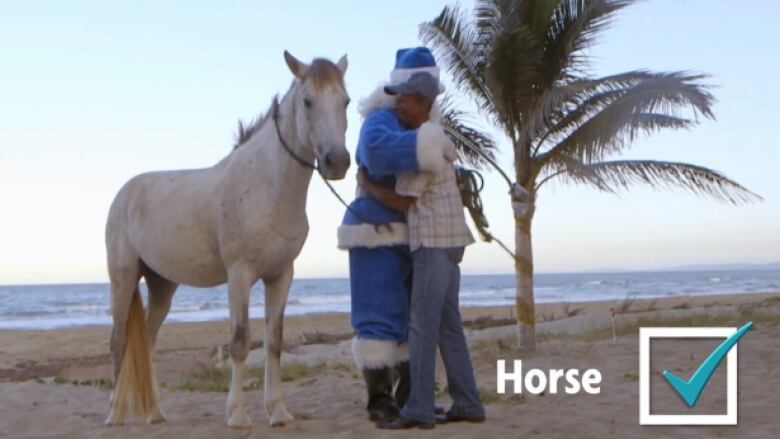From tears to profit: How brands manipulate your emotions to increase holiday sales
Longer online advertisements can leave even the most cold-hearted wiping away tears

The heightened emotions that infuse the holiday season have helped make it prime time for marketers, and this year they seem to befinding that longer online advertisements in particular can leave even the most cold-heartedwiping away tears.
Recent adsfromairlines,tech companies, and evensupermarketshave been incredibly successful.
- WestJet Christmas Miracle video showcases thousands of 'acts of kindness'
- WestJet performs 'mini-miracle' for St. John's family in need
- 7 guerrilla marketing blunders
- Emotional Google ad a viral hit in India and Pakistan
The online realm, it seems, is more flexible, allowingmarketers more time to create entire worlds that pull at the heartstrings.
Over the past couple of years, WestJet has pulled off elaborate holiday stunts which it documented and posted onlinelike delivering personalized gifts to Calgary-bound travellers, and throwing a huge Christmas party for an entire Dominican Republic town.
"When we put out the first video, everyone said it's five and a half minutes it's too long, no one will ever watch it,"said Mike Mills, who works for Studio M, which produces WestJet's holiday ads.
- WatchWednesday night'sThe National to go behindthescenes of WestJet'slatest "12,000 Mini Miracles Day" campaign. View a cliphere.

Butthe naysayers were proven wrong WestJet's holiday videos garnered thousands of views and social media shares.
"If you give people quality content they will sit down and watch any length," Mills says.
And, as he sees it, longer stories allow for a deeper connection."A 30-second or one-minute story is more like a piece of popcorn: it's consumable, yeah it's delicious, but you kind of forget it."
Cause marketing
ElaVeresiu, an assistant marketing professor at York University'sSchulichSchool of Business,calls this approach "cause marketing."
It is one in which companies partner with non-profit groupsor charitable organizations to try to show that they aren't just soulless corporations fixated on profits they want to show that they care.
Mills says it's important for brands to be associated with positive feelings, especially this time of year, since people make choices on an emotional level, even if they aren't aware of it.
"It really is trying to tell a story that people will connect with so that when people see that brand, and later are making a purchasing choice, it leaves them with a positive feeling about that brand."
Risks of going online
The benefits seem clear brands can align themselves with the holiday spirit of sharing and caring, and reach that crucial youth demographic that consumes media primarily online.
But marketers can also run the risk of looking inauthentic, or of failing spectacularly.
"Sometimes it doesn't match with their overall company or even with what they're selling,"says Veresiu. "It shows that they don't really understand the platform."
The Twitter account Brands Saying Baeregularly lambastes companies whose advertisements piggyback onto youth culture by using words like 'bae'and 'fleek,'and employing popular internet memes.
These brands can often end up looking out-of-touch.
A viral, emotional marketing campaign, above all, needs to seem genuine, says Veresiu.
"The danger is that the company is accused of being inauthentic and not at all caring, and at the end of the day, they can be seen as using emotional branding campaigns and viral campaigns just to make a profit,"she says.
Mills echoes the importance of authenticity, saying the holiday season is a great opportunity to create good feelings about a brand. But it's not always appropriate.
"I don't think all brands could jump on the Christmas train because they may not have the same kind of positive feelings in the marketplace that other brands do,"he says.
'The danger is that the company is accused of being inauthentic and not at all caring."- Ela Veresiu, Schulich School of Business, York University
Financial pressure
Technology has made it cheaper to produce videos for a digital platform, leaving room to try new things.
But marketers are also under pressure to make their content sing.
"There is a lot of pressure and the reason is cost savings trying to maximize the efficiency of the budgets,"says DantePirouz, an associate marketing professor atIveyBusiness School andco-authorof a paper that examined what makes aYouTubevideo popular.
Marketers have to justify every dollar they spend on advertising by doubling or even tripling profits.
"And that's a heavy lift for a marketing manager,"she says.
While there doesn't seem to be any magic formula that makes a video viral, there are some key elements: emotion and humour.
"A lot of these viral marketing campaigns are very emotional and they engage in a lot of idealized representations of different values, or of what it means to be human or a man or a woman or family, especially in the context of Christmas,"says Veresiu.
Potential big payoff
Over the past few years, advertisers have begun shifting large portions of their budgets sometimes up to 70 per cent, according to Pirouzaway from traditional commercials and billboards to social media-heavycampaigns.
That's largely becauseentire generations of consumers don't pay much, if any, attention to traditional media, reducing the effectiveness of such costlyadvertising.
Social media campaigns, on the other hand, can be cheaper and made more quickly.
"You're cutting costs hopefully and also hopefully getting access to consumers who are on theinternetor on their phones and not necessarily sitting down watching prime time television or reading a magazine,"saysPirouz.
Jonah Berger, an associate marketing professor at the University of Pennsylvania, whose bookContagious: Why Things Catch Onexamines viral content, says spending on traditional channels like TV and print are way down, while digital and social spending are increasing.
And if a company can connect with a successful viral marketing campaign, the payoutcan be huge.
"Companies have realized that word of mouth is 10 times more effective than traditional advertising. So more and more resources are flowing towards turning customers into advocates," he says.












_(720p).jpg)


 OFFICIAL HD MUSIC VIDEO.jpg)
.jpg)



























































































